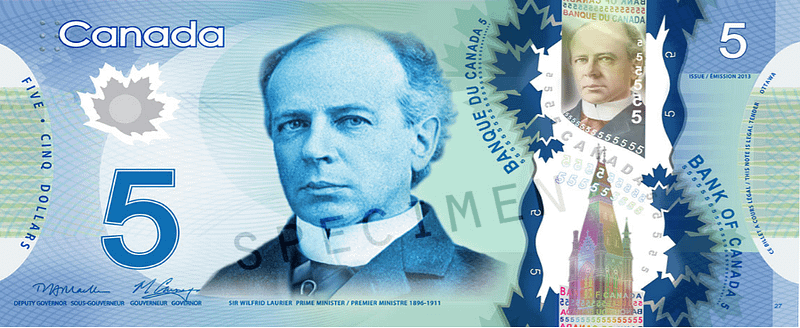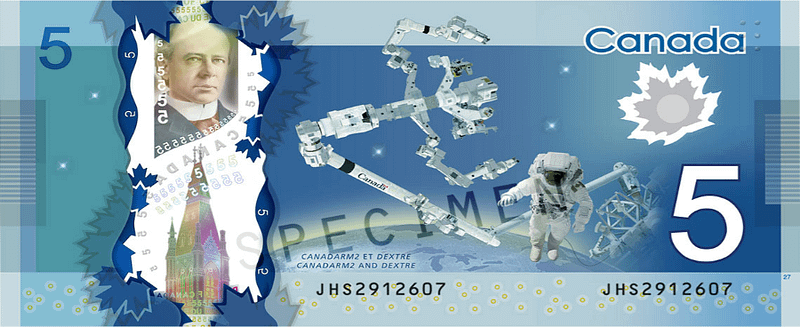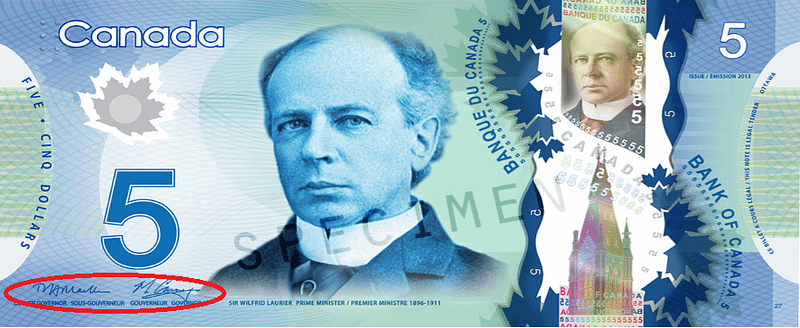5 Things To Know About The Canadian $5 Bill

The Canadian $5 bill is a vital part of Canada’s currency system, and it has a rich history and cultural significance. In this blog post, we’ll take a closer look at the $5 bill, including its design, history, and the role it plays in the Canadian economy.
First of all, it’s worth noting that just like the Canadian $10 bill, the $5 bill is one of the most commonly used denominations in Canada. It’s the perfect balance between being able to make small purchases and still having some financial flexibility. The $5 bill is also an important part of the country’s banknote series, which includes money denominations ranging from $5 to $100.
What Is The History Of The Canadian $5 Bill?
The design of the $5 bill has undergone several changes over the years. The current version, which was introduced in 2013, features a portrait of Sir Wilfrid Laurier. He was the seventh prime minister of Canada. The bill also includes an image of the West Block of Parliament Hill, which is the home of Canada’s federal government.
The history of the $5 bill dates back to the early 20th century, when it was first introduced as part of the Dominion of Canada’s currency system. The first $5 bill featured a portrait of King George V and was issued in 1911. Over the years, the bill has undergone numerous design changes, with the most recent version being introduced in 2013.
The $5 bill has always played a crucial role in the Canadian economy, and it continues to do so today. It is used for a wide range of transactions, including everyday purchases, paying bills, and making larger purchases. The $5 bill is also an important part of the country’s financial system. It is used to facilitate the exchange of goods and services between individuals and businesses.
What Are The Security Features On The Canadian $5 Bill?
Just like for the Canadian $20 Bill, one of the most notable features of the $5 bill is the use of advanced security features to prevent counterfeiting. These include a transparent window featuring a metallic portrait of Sir Wilfrid Laurier, a holographic stripe that displays the word “CANADA” when tilted, and raised ink on the word “BANQUE DU CANADA”, which can be felt with the fingertips.
What Do The Pictures On The Canadian $5 Bill Mean?
The Picture On The Front: Sir Wilfrid Laurier
In addition to its practical use, the $5 bill has also played a significant role in Canadian culture and history. It has served as a symbol of the country’s economic strength and stability, and it has been a source of pride for Canadians. The $5 bill has also been used to honor notable figures in Canadian history, including Sir Wilfrid Laurier, who is featured on the current version of the bill.
Overall, the Canadian $5 bill is a vital part of the country’s currency system and has a rich history and cultural significance. It is used for a wide range of transactions and plays a crucial role in the Canadian economy. The $5 bill is also an important part of Canadian culture and history, and it serves as a symbol of the country’s economic strength and stability.
The Picture On The Back: Canadarm2 & The Astronaut

Canadarm2, Dextre, and the Mobile Base are all robotic systems that are used by the Canadian Space Agency (CSA) and NASA on the International Space Station (ISS).
Canadarm2 is a remotely operated robotic arm that is used to move and position objects in space, including payloads and satellites. It is also used to conduct repairs and maintenance on the ISS. Canadarm2 is an advanced version of the original Canadarm, which was developed by the CSA in the 1980s and is still used on the Space Shuttle.
Dextre, also known as the Special Purpose Dexterous Manipulator, is a two-armed robot that is attached to Canadarm2. It is used to perform tasks that are too delicate or precise for the Canadarm2 to handle, such as handling small tools or repairing electrical components.
The Mobile Base is a mobile platform that is used to transport Canadarm2 and Dextre around the ISS. It consists of a set of wheels and a track system that allows the robotic systems to move around the exterior of the space station. The Mobile Base is used to position Canadarm2 and Dextre for various tasks and to provide them with access to different parts of the ISS.
All three of these robotic systems have played a vital role in the construction and maintenance of the ISS, and they continue to be used in a variety of tasks on the space station. They have also contributed to our understanding of space and have been instrumental in the success of many space missions. They are all featured on the Canadian $5 Bill.
Who Signs The Canadian $5 Dollar Bill?

Right signature: Tiff Macklem
Tiff Macklem became the Deputy Governor of the Bank of Canada in July 2020. He has a long and distinguished career in public service, both at the federal and provincial levels. Prior to his appointment as Governor, he served as Senior Deputy Governor – the Bank’s second-highest ranking position – from 2014 to 2020.
Macklem has a PhD in economics from the University of Toronto and has been a faculty member at both the Rotman School of Management and Western University’s Ivey Business School. He has also held senior positions in the Canadian government, including as Clerk of the Privy Council (the federal government’s top civil servant), Deputy Minister of Finance, and Associate Deputy Minister of Industry.
Left signature: Carolyn Rogers
Carolyn Rogers is the current Deputy Governor of the Bank of Canada and a member of its Board of Directors. She has held this role since 2021, joining from Canadian Imperial Bank of Commerce where she was Senior Executive Vice-President for technology and operations. Prior to her roles at CIBC, Rogers spent 19 years in total with the central bank, including 17 as Chief Risk Officer and two leading up to that as Manager/ Head Risks & Controls Group Financial Markets Department. During her tenure at BOC Carolyn championed changes to modernize internal infrastructure – particularly strengthening financial system stability oversight – through data analytics initiatives, artificial intelligence capabilities within banking supervision activities.
In addition to her roles in the financial industry, Carolyn serves as an External Member of the Takeover Panel and is a Director on the Board of Pollard Banknote. She holds undergraduate degrees from both Dalhousie University (BSc Computer Science) and McGill University (BA Economics).
Where To Get A Canadian 5 Dollar Bill?
You can get a Canadian $5 bill at a variety of places, including banks, credit unions, and currency exchange offices. You can also obtain Canadian dollars at some international airports, hotels, and travel agencies.
If you are in Canada, you can visit a bank or credit union to exchange your currency for Canadian dollars. Most banks and credit unions will have a range of denominations available, including $5 bills. You can also visit a currency exchange office, which typically offers a variety of foreign currencies, including Canadian dollars.
If you are outside of Canada, you can exchange your currency for Canadian dollars at a currency exchange office or through a currency exchange service. Many international airports, hotels, and travel agencies offer currency exchange services. You can also find currency exchange offices in major cities around the world.
Keep in mind that you could need to provide identification and pay a small fee to exchange currency. The rate of exchange may vary depending on the location and the current market rate. It’s always a good idea to shop around and compare rates before exchanging currency to ensure you get the best deal.
